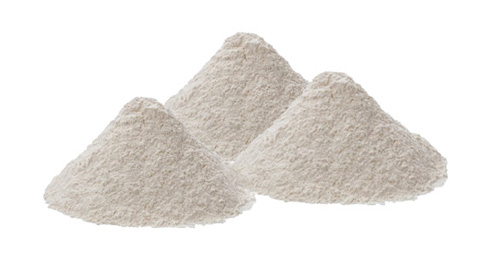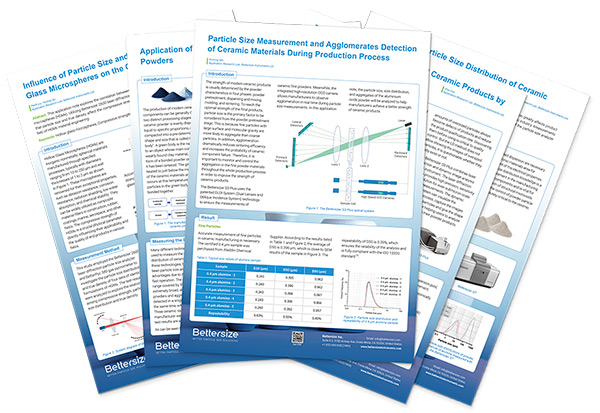Analysis of Particle Size Distribution of Ceramic Powder Based on Laser Diffraction
2021-09-10Application Note
(μm)During ceramic powder processing, the particle size distributions of powder, slurry and granule are different, which are necessary to be monitored. In this note, three forms of aluminium oxide, namely powder, slurry and granule were measured with the Bettersizer ST. And outstanding repeatability was demonstrated through the measurement of a granule sample.
| Product | Bettersizer ST |
| Industry | Ceramics |
| Sample | Aluminium oxide |
| Measurement Type | Particle size |
| Measurement Technology | Laser Diffraction |
Jump to a section:
- Abstract
- The Significance of Particle Size Distribution in the Ceramic Industry
- Worthwhile Partner for Your Quality Control
- Measurement of Particle Size Distribution
- Repeatable Results Provided by the Bettersizer ST
- Conclusion
- Reference
Abstract
Ceramic powder is widely utilized in various application areas, whose particle size distribution greatly affects product performance. This application note introduces the significance of particle size distribution in the ceramic industry. Measurements for particle size of ceramic powder were carried out where the high resolution and good repeatability of the particle size analyzer were demonstrated.
The Significance of Particle Size Distribution in the Ceramic Industry
From ancient times (26,400 BC), the first ceramic statue was made from clay at Brno in the Czech Republic. The first examples of pottery appeared in Eastern Asia several 10 thousand years later (16,400 BC) in the Xianrendong cave in China. One of the first breakthroughs in the fabrication of ceramics was the invention of the wheel, in 1,900 BC by the Sumerians in Mesopotamia. In recent years there have been modern ceramic coatings applied to car bodies, ceramic processing has gained new vigor from nanotechnology, which is allowing manufacturers to introduce materials and products with unconventional properties, such as transparent ceramics, ductile ceramics, hyperelastic bones, and microscopic capacitors. All these inventions play an important role in society and have helped to grow the ceramics world market share of USD 133.20 billion in 2018 and it is projected to reach USD 243.12 billion by 2026. The performance of ceramic products is greatly affected by many factors such as sintering temperature and time, dispersion degree, or particle size distribution of ceramic powder.
The control of particle size distribution of ceramic powder is crucial in many applications, e.g., reduction of particle size and controlled dispersion are necessary in the electronic materials area for improvement of the electrical properties.[1] Particle size distribution knowledge is a major requirement in the manufacturing of ceramic components and is vital for the prevention of structural microvoids. In general, the control of powder particle size is absolutely critical to the ceramic industry.

Worthwhile Partner for Your Quality Control
The Bettersizer ST is a leading particle size analyzer in quality control laboratories throughout the world. It has an efficient built-in wet dispersion system which provides the Bettersizer ST with a rugged and compact design.
It has the added benefit of being able to produce fast QC measurements which assist and do not hold back the manufacturing process. An SOP function ensures the measurements are rapid and easy to provide accurate and repeatable results. Last but not least, economical and simple maintenance provides the user a cost-efficient particle size analyzer with very low running costs.
Measurement of Particle Size Distribution
With the development of technology, different techniques can be applied to measure particle size, of which the laser diffraction technique used by the Bettersizer ST is the best choice for both the measurement of the particle size distribution of ceramic materials but also for detecting coarse/grit particles in a predominantly fine distribution. Aluminium oxide is a good example of ceramic material and it comes in the following forms - powder, pellets, ta blets, sputtering targets and nanoparticles. In this note, the particle size distribution of commercially purchased aluminium oxide powder, slurry and granules were measured with the Bettersizer ST. An aluminium oxide slurry is manufactured through the wet milling of the raw material. In the presence of a spray dryer, granules can be produced from the slurry, and they can be considered as an agglomerate of the powder. The results of the measurements of the powder, slurry and granules are shown below in Figure 1.
As can be expected, the particle size distribution of the granule is larger than those of the powder and slurry. The particle size distribution of the powder and slurry are very similar but these two samples can be distinguished on the comparison graph which is shown in Figure 1, the powder being slightly coarser which demonstrates the high resolution of the Bettersizer ST. Rapid and accurate measurements of different process samples during manufacturing can be easily achieved with the Bettersizer ST, the quality of the product can therefore be ensured.
Repeatable Results Provided by the Bettersizer ST
During manufacturing, a certain application specific particle size distribution is required of the granular powder. A sample was obtained from aluminium oxide granules and measured five times with the Bettersizer ST, whose particle size distributions, D10, D50 and D90 values are shown below in Figure 2 and Table 1, respectively.
The almost perfect overlapping of the five particle size distribution curves and excellent calculated repeatabilities indicate that the Bettersizer ST is capable of providing repeatable results you can trust.

Figure 1: Particle size distributions of powder, slurry and granule of alumina measured with the Bettersizer ST

Figure 2: Particle size distribution of five measurements of granule
|
Sample |
D10 (μm) |
D50 (μm) |
D90 (μm) |
|
Granule 1-1 |
75.18 |
146.6 |
270.7 |
|
Granule 1-2 |
75.99 |
148.4 |
273.6 |
|
Granule 1-3 |
76.12 |
148.9 |
274.2 |
|
Granule 1-4 |
75.48 |
148.1 |
273.2 |
|
Granule 1-5 |
76.38 |
149.1 |
274.2 |
|
Repeatability |
0.65% |
0.67% |
0.53% |
Table 1: Comparison of D10, D50 and D90 of five measurements of granule and corresponding repeatabilities
Conclusion
Three forms of aluminium oxide, namely powder, slurry and granule were measured with the Bettersizer ST. Outstanding repeatabilities were demonstrated by the measurements of the most difficult of these samples – the granule sample. Consequently, the Bettersizer ST can be a valuable partner for product quality control from both an accuracy and repeatability perspective.
Reference
[1] Deb Shechter (Sep 8, 2015). Particle Size Reduction & Distribution in the Ceramics Industry. Link
About the Author
 |
Wenjian Zhou Application Engineer @ Bettersize Instruments |
|
Want to achieve high-performance ceramics materials? |
 |
Recommended articles
Rate this article
